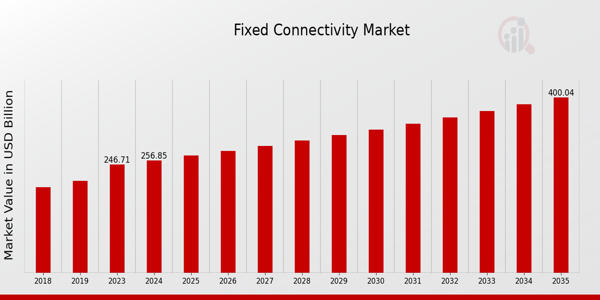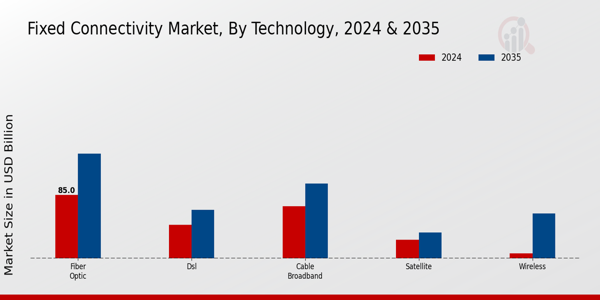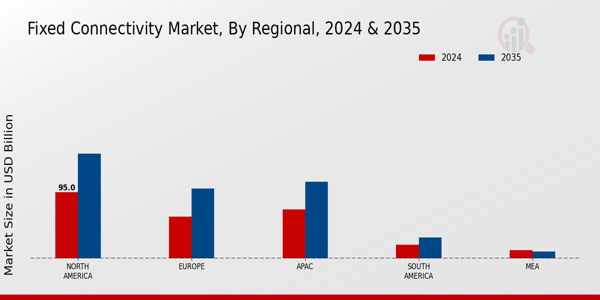Fixed Connectivity Market Overview
The Fixed Connectivity Market Size was estimated at 246.71 (USD Billion) in 2023. The Fixed Connectivity Market Industry is expected to grow from 256.85(USD Billion) in 2024 to 400.0 (USD Billion) by 2035. The Fixed Connectivity Market CAGR (growth rate) is expected to be around 4.11% during the forecast period (2025 - 2035).
Key Fixed Connectivity Market Trends Highlighted
The Global Fixed Connectivity Market is growing due to the increasing need for fixed internet access and reliable connectivity. The market's key drivers encompass the adoption of remote working, the growth of digital services, and increased dependency on cloud computing or SaaS applications. Remote and Cloud Services make it necessary for all entities, personal and business-oriented, to have reliable fixed connectivity services. Services such as fixed wireless access have the potential to meet this market demand. Furthermore, technology and infrastructure sophistication add another layer to the market dynamics.
The Global Fixed Connectivity has a lot to offer and has numerous untapped possibilities. The increasing deployment of fiber-optic networks presents a prime opportunity for service providers to enhance the quality of service they offer. Furthermore, the advancement of 5G technology opens up new avenues for fixed wireless access, which can cater to areas that are difficult to connect through traditional means. These opportunities can be harnessed to improve overall connectivity and potentially reach underserved regions. Trends in recent times indicate a strong shift towards more integrated solutions that combine fixed and mobile services. Consumers are looking for seamless connectivity that allows them to move freely between devices without losing the quality of service.
This trend is prompting providers to develop bundled offerings that cater to both fixed and mobile needs. Increased competition among service providers is also leading to innovative pricing models and enhanced service plans. The focus on customer experience and satisfaction is becoming a pivotal aspect of service delivery as companies strive to meet the diverse needs of their clientele.

Source: Primary Research, Secondary Research, MRFR Database and Analyst Review
Fixed Connectivity Market Drivers
Growing Demand for High-Speed Internet
The increasing reliance on high-speed internet in both residential and commercial sectors is a pivotal driver for the Global Fixed Connectivity Market Industry. As the digital landscape evolves rapidly, consumers and businesses alike are necessitating faster and more reliable internet connections to support a plethora of applications, ranging from streaming services and online gaming to telecommuting and cloud-based solutions. This surge in demand is further catalyzed by advancements in technology and the proliferation of devices connected to the internet. With every advancement in technology, including the Internet of Things (IoT), smart home devices, and advanced telecommunications, the expectations of connectivity speed and reliability are rising.
Consequently, service providers are incentivized to invest heavily in developing the infrastructure needed to meet these consumer demands, leading to an expansion of their services and reach. Moreover, as industries transition to digital-first models to improve efficiency and productivity, the need for stable connections that the Global Fixed Connectivity Market Industry provides becomes more pronounced. This trend suggests sustained growth in the market as more households and enterprises seek to upgrade their connectivity options to keep up with the demands of an increasingly connected environment.
Expansion of Smart Cities
The development of smart cities is a significant driving force in the Global Fixed Connectivity Market Industry. As urban areas around the world enhance their infrastructure to incorporate smart technologies, the necessity for robust fixed connectivity becomes essential. These smart initiatives often rely on interconnected systems and IoT devices that require reliable broadband connectivity to function effectively. The integration of smart grids, intelligent transportation systems, and enhanced public services can only thrive on a strong fixed connectivity backbone, making this an attractive area for investment and growth.
Rising Adoption of Remote Work
The shift towards remote work and flexible work arrangements has accelerated the demand for fixed connectivity solutions. As businesses adapt to new working models, employees require dependable internet access to collaborate effectively from various locations. This trend pushes companies to invest in high-quality connectivity services to maintain productivity and staff engagement, thereby boosting the Global Fixed Connectivity Market Industry.
Fixed Connectivity Market Segment Insights
Fixed Connectivity Market Technology Insights
The Global Fixed Connectivity Market has been significantly shaped by advancements in technology, reflecting a diverse range of services designed to meet the growing demand for reliable internet access. In 2024, the overall market was valued at 256.85 USD Billion, indicating a robust landscape paved by innovation and investment. A significant contributor to this market is the Fiber Optic segment, which is projected to hold a value of 85.0 USD Billion in 2024 and is expected to rise to 140.0 USD Billion by 2035. This dominance arises from fiber optics' ability to deliver high-speed internet with lower latency and greater bandwidth compared to other forms of connectivity, leading to increased adoption in homes and businesses alike. Following closely, the DSL segment showcases its importance with a valuation of 45.0 USD Billion in 2024, which is projected to increase to 65.0 USD Billion by 2035.
DSL technology plays a crucial role as it utilizes existing telephone lines, making it widely accessible in rural and underserved areas, which boosts its demand and sustains market relevance. The Cable Broadband segment also proves to be significant, standing at 70.0 USD Billion in 2024, and anticipated to grow to 100.0 USD Billion by 2035. It delivers faster speeds compared to traditional DSL and is often the go-to solution for consumers until fiber networks become available. Meanwhile, the Satellite segment is valued at 25.0 USD Billion in 2024, with an increase to 35.0 USD Billion by 2035. It remains a vital player, especially in remote areas where terrestrial connectivity is challenging, providing crucial connectivity for users who otherwise may have limited options. Lastly, the Wireless segment, despite having a smaller valuation of 6.85 USD Billion in 2024, is projected to surge dramatically to 60.0 USD Billion by 2035, potentially driven by the proliferation of mobile devices and the necessity for more flexible and rapid internet solutions.
Together, these diverse segments of the Global Fixed Connectivity Market underscore a trend toward increased bandwidth and connectivity options driven by consumer demand, technological innovation, and changing market dynamics that promise substantial growth opportunities across the board. The overall market's growth trajectory is influenced by a combination of factors, including expanding internet usage, the shift towards remote work, and the increasing importance of reliable connectivity for daily business operations and personal use, making the analysis of this technology segment critical for understanding future trends in the Global Fixed Connectivity Market revenue, segmentation, and industry statistics.

Source: Primary Research, Secondary Research, MRFR Database and Analyst Review
Fixed Connectivity Market Service Type Insights
The Global Fixed Connectivity Market is projected to reach a valuation of 256.85 USD Billion in 2024, with significant contributions from various service types. The segmentation of this market showcases three primary areas: Residential, Commercial, and Government. The Residential sector holds a major share due to the increasing demand for high-speed internet and smart home connectivity, which have become essential amid growing consumer dependency on digital services. The Commercial segment is also significant, as businesses look for reliable connectivity solutions to enhance productivity, especially with the rise of remote work environments.
Additionally, the Government sector plays a crucial role, prioritizing investments in digital infrastructure to ensure efficient public service delivery and maintain connectivity in communities. The collective trends in this market reflect a robust growth trajectory driven by technological advancements and the need for robust communication frameworks. Keeping an eye on these developments and the evolving demand dynamics within the Global Fixed Connectivity Market will provide essential insights for stakeholders looking to capitalize on emerging opportunities.
Fixed Connectivity Market Network Type Insights
The Global Fixed Connectivity Market, which reached a valuation of 256.85 USD Billion in 2024, showcases a diverse landscape within the Network Type segment. This segment is primarily characterized by three key networks: Private, Public, and Hybrid Networks. Private Networks are gaining traction due to their enhanced security and reliability, making them essential for businesses that prioritize data protection. Public Networks dominate in terms of accessibility and cost-effectiveness, appealing to a vast user base and supporting various applications. Meanwhile, Hybrid Networks present an integrated approach, combining the strengths of both private and public networks, thereby accommodating diverse operational needs.
The growing demand for seamless connectivity is a significant driver of this segment's evolution, spurred by the rise of remote work and digital transformation initiatives. As organizations increasingly seek solutions that balance security and scalability, the importance of these network types becomes ever more pronounced, contributing to the overall market growth. The Global Fixed Connectivity Market segmentation reveals valuable insights into how different network types cater to varying user needs, ultimately influencing market trends and future developments.
Fixed Connectivity Market Deployment Type Insights
The Deployment Type segmentation within the Global Fixed Connectivity Market encompasses various delivery models that cater to diverse business needs, with significant insights into On-Premise and Cloud-Based strategies. By 2024, the overall Global Fixed Connectivity Market is expected to be valued at 256.85 billion USD, highlighting the market's robust position. The On-Premise segment has gained traction as organizations seek greater control over their data and infrastructure, leading to a considerable portion of the market share. Conversely, the Cloud-Based model is notable for its flexibility and scalability, which has increasingly attracted businesses looking to reduce operational costs and streamline operations.
These deployment types are essential as they reflect the evolving needs of businesses in a digital-first world, driving advancements in technology. As more enterprises transition to hybrid models, understanding the preferences between On-Premise and Cloud-Based solutions becomes vital for market participants. Current trends show a growing preference for Cloud-Based services, emphasizing efficiency and ease of access, which complements the overall growth trajectory of the Global Fixed Connectivity Market.
Fixed Connectivity Market Regional Insights
The Global Fixed Connectivity Market is projected to be valued at 256.85 USD Billion in 2024, showcasing robust growth across various regions. North America holds a dominant position with a valuation of 95.0 USD Billion, reflecting its majority holding and the importance of advanced technological infrastructure. Europe, valued at 60.0 USD Billion, is significant as it continues to adopt innovative connectivity solutions. The APAC region, estimated at 70.0 USD Billion, is growing rapidly due to increasing internet penetration and digital transformation, making it a vital area for future expansion. In contrast, South America holds a smaller market valuation at 20.0 USD Billion; however, it presents emerging opportunities for growth due to rising demands for connectivity. Meanwhile, the MEA region, valued at 11.85 USD Billion, faces challenges but has the potential for further development in fixed connectivity solutions, indicating a mixed landscape of opportunity and obstacles. These figures reveal the Global Fixed Connectivity Market segmentation and underline the varied growth dynamics within the regional landscape, highlighting key trends and drivers influencing market trajectories.

Source: Primary Research, Secondary Research, MRFR Database and Analyst Review
Fixed Connectivity Market Key Players and Competitive Insights
The Global Fixed Connectivity Market is characterized by intense competition among key players striving to establish a dominant presence while innovating to meet consumer demands. The increasing need for high-speed internet, coupled with the growing reliance on digital services across various sectors, is driving companies to enhance their offerings and deliver reliable connectivity solutions. This market landscape is marked by rapid technological advancements, evolving consumer preferences, and the integration of next-generation technologies such as fiber optics and satellite communication. Companies are continually adapting their strategies to navigate challenges like regulatory changes and market saturation, focusing on enhancing customer experience and expanding their service reach.
As businesses and individuals seek more efficient and effective connectivity solutions, understanding competitive dynamics becomes pivotal for success in this multifaceted environment. Verizon Communications stands out in the Global Fixed Connectivity Market due to its extensive network infrastructure and robust service offerings. With a commitment to providing high-quality connectivity, Verizon has developed one of the largest fiber networks, enabling it to deliver fast and reliable internet services to both residential and commercial customers. The company has consistently invested in technology and infrastructure, ensuring it remains at the forefront of innovation. Verizon's strengths lie in its strong brand reputation, customer service excellence, and high-speed offerings that meet the demands of an increasingly digital world.
Their proactive approach to expanding fiber coverage and enhancing broadband access positions them favorably within the competitive landscape, allowing Verizon to cater to a diverse range of customer needs effectively. Charter Communications also holds a significant position in the Global Fixed Connectivity Market, leveraging its substantial cable infrastructure to provide a variety of connectivity solutions. The company has successfully integrated high-speed internet services, advanced television offerings, and voice services, creating a comprehensive package that appeals to a wide array of consumers. Charter's strength is attributed to its commitment to enhancing user experience through consistent service upgrades and customer engagement initiatives. Moreover, its strategic focus on expanding broadband access in underserved areas reflects its dedication to bridging the digital divide, thereby enhancing its market presence. Charter's ability to adapt to evolving technological trends and consumer demands further solidifies its status as a key competitor in the market, driving innovations that shape the future of fixed connectivity solutions.
Key Companies in the Fixed Connectivity Market Include
- Verizon Communications
- Charter Communications
- TMobile US
- Deutsche Telekom
- Nippon Telegraph and Telephone
- BT Group
- AT and T
- SingTel
- Centurylink
- Orange
- Comcast
- Airtel
- Vodafone Group
- China Telecom
Fixed Connectivity Market Industry Developments
Recent developments in the Global Fixed Connectivity Market have showcased significant activities among major players. Verizon Communications has recently announced enhancements to its fiber optic network, aiming to boost broadband speeds and service availability, reflecting an ongoing commitment to expanding its infrastructure. Charter Communications is also progressing with its 5G home internet offerings, with ongoing investments designed to improve connectivity. T-Mobile US is exploring partnerships to expand its fixed wireless access solutions, positioning itself as a competitive contender.
On the international front, Deutsche Telekom continues to enhance its connectivity solutions across Europe, while Nippon Telegraph and Telephone is focusing on integrating broadband offerings with its existing telecom services. BT Group has been active in promoting its full-fiber network, aspiring to reach more customers by 2025. In terms of M&A activity, there have been discussions about strategic partnerships and potential acquisitions among these firms, particularly in efforts to consolidate services and improve operational efficiencies. Market valuation growth across these companies indicates robust demand for fixed connectivity solutions, which is impacting service offerings and competition within the sector.
Fixed Connectivity Market Segmentation Insights
Fixed Connectivity Market Technology Outlook
- Fiber Optic
- DSL
- Cable Broadband
- Satellite
- Wireless
Fixed Connectivity Market Service Type Outlook
- Residential
- Commercial
- Government
Fixed Connectivity Market Network Type Outlook
- Private Network
- Public Network
- Hybrid Network
Fixed Connectivity Market Deployment Type Outlook
Fixed Connectivity Market Regional Outlook
- North America
- Europe
- South America
- Asia-Pacific
- Middle East and Africa
|
Report Attribute/Metric
|
Details
|
|
Market Size 2023
|
246.71(USD Billion)
|
|
Market Size 2024
|
256.85(USD Billion)
|
|
Market Size 2035
|
400.0(USD Billion)
|
|
Compound Annual Growth Rate (CAGR)
|
4.11% (2025 - 2035)
|
|
Report Coverage
|
Revenue Forecast, Competitive Landscape, Growth Factors, and Trends
|
|
Base Year
|
2024
|
|
Market Forecast Period
|
2025 - 2035
|
|
Historical Data
|
2019 - 2024
|
|
Market Forecast Units
|
USD Billion
|
|
Key Companies Profiled
|
Verizon Communications, Charter Communications, TMobile US, Deutsche Telekom, Nippon Telegraph and Telephone, BT Group, AT and T, SingTel, Centurylink, Orange, Comcast, Airtel, Vodafone Group, China Telecom
|
|
Segments Covered
|
Technology, Service Type, Network Type, Deployment Type, Regional
|
|
Key Market Opportunities
|
Rising demand for high-speed internet, Expanding smart home device adoption, Increasing rural broadband initiatives, Enhancements in fiber optic infrastructure, Growth in enterprise connectivity solutions
|
|
Key Market Dynamics
|
growing internet penetration, demand for high-speed connectivity, increasing adoption of IoT, cost-effective broadband solutions, government infrastructure investments
|
|
Countries Covered
|
North America, Europe, APAC, South America, MEA
|
Frequently Asked Questions (FAQ) :
In 2024, the Global Fixed Connectivity Market is expected to be valued at 256.85 USD Billion.
By 2035, the Global Fixed Connectivity Market is projected to reach a valuation of 400.0 USD Billion.
The expected CAGR for the Global Fixed Connectivity Market from 2025 to 2035 is 4.11%.
North America is expected to hold the largest market share in the Global Fixed Connectivity Market with a valuation of 95.0 USD Billion in 2024.
The Fiber Optic segment of the Global Fixed Connectivity Market is expected to be valued at 140.0 USD Billion by 2035.
Major players in the Global Fixed Connectivity Market include Verizon Communications, Charter Communications, and Deutsche Telekom among others.
The DSL segment is expected to be valued at 45.0 USD Billion in 2024 within the Global Fixed Connectivity Market.
The APAC region is anticipated to grow from a market size of 70.0 USD Billion in 2024 to 110.0 USD Billion by 2035.
The Wireless segment is expected to show significant growth, increasing from 6.85 USD Billion in 2024 to 60.0 USD Billion by 2035.
By 2035, the Cable Broadband segment of the Global Fixed Connectivity Market is expected to reach a valuation of 100.0 USD Billion.
















